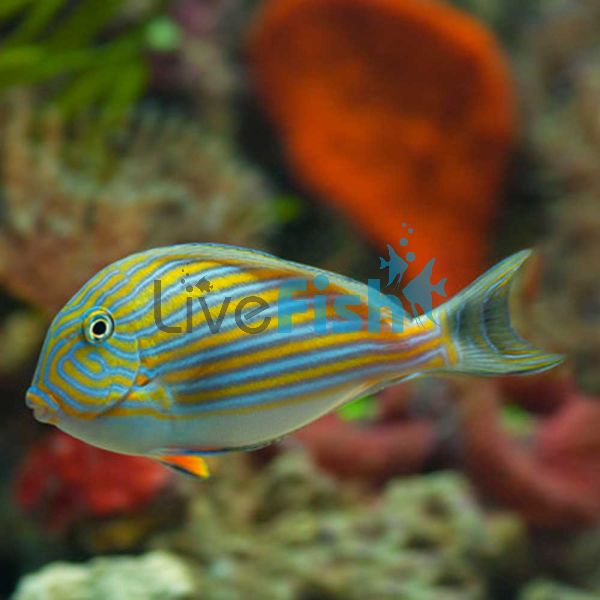Tang Clown Lined Surgeonfish - Medium
The Clown Tang is covered in vivid yellow and blue stripes which extend from around the eye, down the body. Its small dorsal and anal fins tuck in behind a streamlined tailfin. At the base of the tailfin are venomous spines on either side of the Caudal Peduncle. The lower body area below the mouth and tailfin is a paler blue color. This one of the most aggressive and territorial Tangs. Housing it with conspecifics or fish of a similar shape/color can cause problems.
Clown Tang
The Clown Tang is covered in vivid yellow and blue stripes which extend from around the eye, down the body. Its small dorsal and anal fins tuck in behind a streamlined tailfin. At the base of the tailfin are venomous spines on either side of the Caudal Peduncle. The lower body area below the mouth and tailfin is a paler blue colour. This one of the most aggressive and territorial Tangs. Housing it with conspecifics or fish of a similar shape/colour can cause problems.
This is a difficult species to breed in captivity. In the wild, they will form small harems with 1 male and several females. Their breeding season occurs between October and February. Clown Tangs form pairs and are pelagic spawners.
This species’ natural environment is in Indo-Pacific waters. It can be found in locations such as Hawaii, Japan, the Great Barrier Reef, and the Maldives. They inhabit shallow reef areas to a depth of around 15 metres. Adults form schools, while juveniles tend to be solitary.
Tank Recommendations for Clown Tangs
Tank size should be at least 6 feet long and 250 gallons (946 litres).
Clown Tangs are reef safe and won't bother corals or invertebrates. A suitable aquarium should include plenty of Live Rock. Aquarists can arrange it to create plenty of hiding places. There also needs to be a large amount of open space for them to swim around.
Water quality needs to be of the highest quality. Oxygenation, cleanliness, and a good water flow are essential. Established aquariums are most suitable, with small nitrate & phosphate nutrient levels. There should be no trace of ammonia or nitrite.
Suitable Tank Buddies
Clown Tangs are a semi-aggressive species. They can be intolerant to tank buddies, especially newbies. Introducing a Tang as one of the last fish in an aquarium can help counter this.
Usually Compatible
Corals and invertebrates aren't at risk from Clown Tangs. Fish of similar size should also avoid any issues unless they look similar in colour and shape. Suitable tank buddies include Anglers or Frogfish, Eels, Groupers, Lionfish or Scorpionfish
Sometime Compatible
It may be possible to house a Clown Tang with other Tangs. But they should be of a different shape and colour and will need monitoring. Care is due when housing Tangs with Batfish, Rabbitfish, Triggers, Sharks and Rays
Rarely Compatible
Avoid housing Clown Tangs with other Tangs that are similar in size, shape or colour. Pipefish or Seahorses are not suitable tank buddies for this species.
Feeding Your Clown Tang
Clown Tangs are omnivores. They will consume meaty foods such as Mysis and Krill when introduced to the tank. But they also need plenty of plant-based food. A suitable diet will include spirulina, marine algae, and seaweed such as Nori. Seaweed can be attached to rock with a vegetable clip. Products such as Ocean Nutrition, and Sea Veggies are suitable as well as flake food and pellets. Feeding should take place at least 3 times per week.
| Scientific Name | Acanthurus Lineatus |
|---|---|
| Care Level | Hard |
| Common Names | Clown Tang, Clown Surgeonfish, Striped Surgeonfish, Striped Surgeon, Blue banded Surgeonfish, Lined Surgeon, Lined Surgeonfish, Bluelined Surgeonfish |
| Diet | Omnivore |
| Fish Family | Acanthuridae |
| Lifespan (years) | 10 |
| Max. Length (cm) | 38 |
| Min. Tank Volume (l) | 946 |
| Origin | Indo-Pacific - Hawaii, Japan, Great Barrier Reef, Maldives |
| Reef Safe | Yes |
| Sociability | Semi-aggressive |
| Venomous | No |
| Water Conditions | 22.5-25.5°C (72-78° F), dKH 8-12, pH 8.1-8.4, sg 1.020-1.025 |




